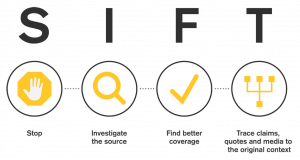Evaluate Web Sources
Because anyone can make a website and publish information on the open web without it being fact checked, it’s extra important to critically evaluate what you find before you include it in your academic research. The S.I.F.T. method lays out 4 moves, or steps you can take, as you investigate each source.

STOP
When you first encounter a source, before you start to read it, STOP and ask yourself whether you know or trust the source of information. If you don’t, use the next 3 moves, or steps, to get a better understanding of what you are looking at.
Do not read, share, or use the source in your research until you know what it is, and you can verify it is reliable.
Investigate the Source
Take time to figure out what you are reading before you read it. Investigating the source will help you decide if it is worth your time. It will give you a better understanding of the significance of the source and it’s trustworthiness. Fact-checkers read “laterally” across many websites. That is, they don’t spend much time on the source itself, but instead they quickly get off the page and see what others have said about the source to get the big picture.
Find Trusted Coverage
When you come across information, or a claim, you will want to know if it is true or false. Does it represent a consensus viewpoint, or is it the subject of disagreement? Is it broadly accepted or rejected, or something in between? By scanning for other coverage, you can see what the expert consensus is, learn the history around it, and ultimately land on a better source. Find a more trusted, more in-depth, source that better fits your needs.
Trace Claims, Quotes, and Media Back to the Original Context
Most stuff you see on the web is not original reporting, but is re-reporting, sometimes with added commentary. Oftentimes it has been stripped of its original context and references. This is particularly true in social media which tends to sensationalize stories for clicks. Locating the original story, or research, will give you a more complete and accurate version of the information.
SIFT text and graphics adapted from “SIFT (The Four Moves)” by Mike Caulfield, licensed under CC BY 4.0

